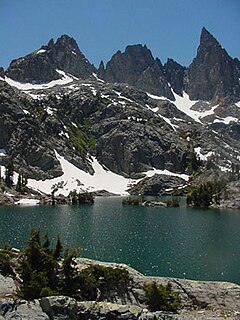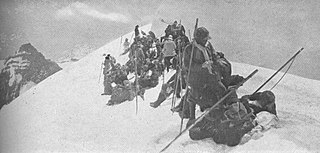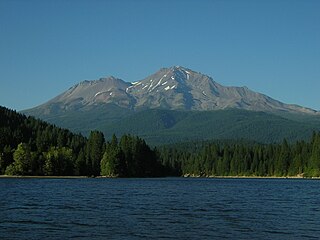
The Sierra Club is an environmental organization with chapters in all 50 United States, Washington D.C., and Puerto Rico. The club was founded on May 28, 1892, in San Francisco, California, by the Scottish-American preservationist John Muir, who became the first president, as well as the longest serving president at approximately 20 years in this leadership position. The Sierra Club operates only in the United States. Sierra Club Canada is separated from the Sierra Club.

NOLS - also known as the National Outdoor Leadership School is a non-profit outdoor education school based in the United States dedicated to teaching environmental ethics, technical outdoors skills, wilderness medicine, risk management and judgment, and leadership on extended wilderness expeditions and in traditional classrooms. The NOLS mission is to be the leading source and teacher of wilderness skills and leadership that serve people and the environment. NOLS runs courses on six continents, with courses in a variety of wilderness environments and for almost any age group.

David Ross Brower was a prominent environmentalist and the founder of many environmental organizations, including the John Muir Institute for Environmental Studies, Friends of the Earth (1969), Earth Island Institute (1982), North Cascades Conservation Council, and Fate of the Earth Conferences. From 1952 to 1969, he served as the first Executive Director of the Sierra Club, and served on its board three times: from 1941–1953; 1983–1988; and 1995–2000 as a petition candidate enlisted by reform-activists known as the John Muir Sierrans. As a younger man, he was a prominent mountaineer.

An ice axe is a multi-purpose hiking and climbing tool used by mountaineers in both the ascent and descent of routes that involve frozen conditions with snow or ice. An ice axe can be held and employed in a number of different ways, depending on the terrain encountered. In its simplest role, the ice axe is used like a walking stick in the uphill hand, the mountaineer holding the head in the center. It can also be buried pick down, the rope tied around the shaft to form a secure anchor on which to bring up a second climber, or buried vertically to form a stomp belay. The adze is used to cut footsteps, as well as scoop/bucket seats in the hillside and trenches to bury an ice axe belay. The long-handled alpenstock was a predecessor to the modern ice axe.

Mountaineering: The Freedom of the Hills is often considered the standard textbook for mountaineering and climbing in North America. The book was first published in 1960 by The Mountaineers of Seattle, Washington. The book was written by a team of over 40 experts in the field.

The Minarets are a series of jagged peaks located in the Ritter Range, a sub-range of the Sierra Nevada Mountains in the state of California. They are easily viewed from Minaret Summit, which is accessible by auto. Collectively, they form an arête, and are a prominent feature in the Ansel Adams Wilderness which was known as the Minaret Wilderness until it was renamed in honor of Ansel Adams in 1984.

Survival skills are techniques that a person may use in order to sustain life in any type of natural environment or built environment. These techniques are meant to provide basic necessities for human life which include water, food, and shelter. The skills also support proper knowledge and interactions with animals and plants to promote the sustaining of life over a period of time. Survival skills are often associated with the need to survive in a disaster situation. Survival skills are often basic ideas and abilities that ancients invented and used themselves for thousands of years. Outdoor activities such as hiking, backpacking, horseback riding, fishing, and hunting all require basic wilderness survival skills, especially in handling emergency situations. Bushcraft and primitive living are most often self-implemented, but require many of the same skills.

The Mountaineers is an alpine club serving the state of Washington. Founded in 1906, it is organized as an outdoor recreation, education, and conservation 501(c)(3) nonprofit, and is based in Seattle, Washington. The Mountaineers host a wide range of outdoor activities, primarily alpine mountain climbing and hikes. The club also hosts classes, training courses, and social events.

The Alpine Club of Canada (ACC) is an amateur athletic association with its national office in Canmore, Alberta that has been a focal point for Canadian mountaineering since its founding in 1906. The club was co-founded by Arthur Oliver Wheeler, who served as its first president, and Elizabeth Parker, a journalist for the Manitoba Free Press. Byron Harmon, whose 6500+ photographs of the Canadian Rockies in the early 20th century provide the best glimpse of the area at that time, was official photographer to the club at its founding. The club is the leading organization in Canada devoted to climbing, mountain culture, and issues related to alpine pursuits and ecology. It is also the Canadian regulatory organization for climbing competition, sanctioning local, regional and national events, and assembling, coaching and supporting the national team.

Mount Agassiz, at 13,899 feet (4,236 m), is one of the twenty highest peaks of California. It is the northernmost and easiest to climb of the major Palisades summits. This peak is not to be confused with the 9967ft peak by the same name in Desolation Wilderness, also in the California Sierra.

The South Sierra Wilderness is a federally designated wilderness area in the Southern Sierra Nevada, in eastern California. It is located 65 miles (105 km) northeast of Bakersfield, and is southwest of Owens Lake and Olancha.

The Army Mountain Warfare School (AMWS) is a United States Army school located at the Camp Ethan Allen Training Site, Jericho, Vermont to train soldiers in mountain warfare, the specialized skills required for operating in mountainous terrain. It is home to the 86th Infantry Brigade Combat Team. The school is located in Vermont's Green Mountains.

The Mount Shasta Wilderness is a 38,200-acre (155 km2) federally designated wilderness area located 5 miles (8.0 km) east of Mount Shasta City in northern California. The US Congress passed the 1984 California Wilderness Act that set aside the Mount Shasta Wilderness. The US Forest Service is the managing agency as the wilderness is within the Shasta-Trinity National Forest. The area is named for and is dominated by the Mount Shasta volcano which reaches a traditionally quoted height of 14,162 feet (4,317 m) above sea level, but official sources give values ranging from 14,104 feet (4,299 m) from one USGS project, to 14,179 feet (4,322 m) via the NOAA. Mount Shasta is one of only two peaks in the state over 14,000 feet (4,300 m) outside the Sierra Nevada Mountain Range. The other summit is White Mountain Peak in the Great Basin of east-central California.

Outdoor recreation or outdoor activity refers to recreation engaged in out of doors, most commonly in natural settings. The activities themselves — such as fishing, hunting, backpacking, and horseback riding — are characteristically dependent on the environment practiced in.

Jules Marquard Eichorn was an American mountaineer, environmentalist, and music teacher.
Allen Steck is an American mountaineer and rock climber. He is a native of Oakland, California.

Robert Lindley Murray Underhill was an American mountaineer best known for introducing modern Alpine style rope and belaying techniques to the U.S. climbing community in the late 1920s and early 1930s.
The High Trips were large annual wilderness excursions organized and led by the Sierra Club, beginning in 1901. The High Trips lasted until the early 1970s, and were replaced by a larger number of smaller trips to wilderness areas worldwide.
The Sierra Peaks Section (SPS) is a mountaineering society within the Angeles Chapter of the Sierra Club that serves to provide mountaineering activities for Sierra Club members in the Sierra Nevada, and to honor mountaineers who have summited Sierra Nevada peaks.
















